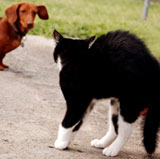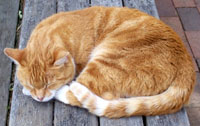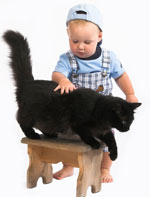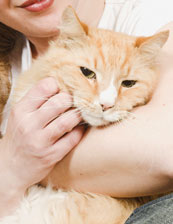|
 Solve the mystery: Indeed, cats are quite mysterious... however, if you are willing to be observant and patient, some mysteries in their behavior might be a little easier to understand! Solve the mystery: Indeed, cats are quite mysterious... however, if you are willing to be observant and patient, some mysteries in their behavior might be a little easier to understand!
Be a cat detective: All cats are different in their behavior, tolerance and likes, but there are some general patterns that people can use to determine how the cat is feeling. Cat personality and likes vary widely, however by interpreting their feelings and patiently learning about a cat, people can learn what their cat likes or dislikes.
The tail says it all: Watching a cat's tail is an excellent way to determine how they are feeling. If you get bitten by a cat, mostly likely you missed the warning signs - a primary one from her tail...

Friendly and raised: Usually a cat with a raised tail (sometimes with a slightly bent tip), accompanied by their ears up high, is happy to see you and might approach you in a friendly greeting. You may also see cats approaching each other with raised tails with bent tips... these cats are being friendly!
 Wagging tail = bad: Unlike a dog, a wagging cat tail does not mean they are happy to see you! You can tell a lot by a cat tail, and when it's moving in a wag, that generally means something or someone is being annoying. The more frustrated a cat gets with
the situation, the more forcefully the tail will move - if your cat's tail starts thrashing, it might soon be accompanied by a growl and you had better watch out! If you are petting or holding a cat and ignore the signs, you might get swiped with her paw next! Wagging tail = bad: Unlike a dog, a wagging cat tail does not mean they are happy to see you! You can tell a lot by a cat tail, and when it's moving in a wag, that generally means something or someone is being annoying. The more frustrated a cat gets with
the situation, the more forcefully the tail will move - if your cat's tail starts thrashing, it might soon be accompanied by a growl and you had better watch out! If you are petting or holding a cat and ignore the signs, you might get swiped with her paw next!
 Twitching curiosity: While a lashing cat tail usually implies anger, a little bit of twitching does not necessarily mean that. It could be the cat is unsure of something, combined with a little excitement or curiosity. If you see a cat crouched on the ground staring at
something with a little slow twitching of the tail tip - chances are something looks interesting! Twitching curiosity: While a lashing cat tail usually implies anger, a little bit of twitching does not necessarily mean that. It could be the cat is unsure of something, combined with a little excitement or curiosity. If you see a cat crouched on the ground staring at
something with a little slow twitching of the tail tip - chances are something looks interesting!
 Fluffy fear: When a cat's tail is puffed up and looks bristled, the cat is feeling afraid, threatened and could either be on the defensive or offensive.This is usually accompanied by an arched back. The more the puffed-up tail is positioned down or straight out, the more likely she is going more towards aggression. Her ears will be back, and she may be hissing, spitting or growling. Fluffy fear: When a cat's tail is puffed up and looks bristled, the cat is feeling afraid, threatened and could either be on the defensive or offensive.This is usually accompanied by an arched back. The more the puffed-up tail is positioned down or straight out, the more likely she is going more towards aggression. Her ears will be back, and she may be hissing, spitting or growling.
Usually a cat will do this in reaction to another intruding animal, whether it be another cat, or maybe a dog. If a cat's tail is puffed because of your presence , then you have spooked her! Talk reassuringly and back away.. let her know you aren't a threat, but be cautious about coming too close!

The curled around tail: When the tail is wrapped around the cat's body, it could mean a few things. If the cat is nervous, it is a defensive body position. Otherwise, it usually means contentment. If it's accompanied by half-closed eyes and purring - it's definitely contentment!
 How to pet a cat: Cats have different tolerances to petting. Some cats love being pet all over, while others do not like to be touched at all. Safer areas to try petting a cat are behind her ears, under her chin and near the base of her tail. How to pet a cat: Cats have different tolerances to petting. Some cats love being pet all over, while others do not like to be touched at all. Safer areas to try petting a cat are behind her ears, under her chin and near the base of her tail.
Watch for the tell-tail signs:
Keep an eye out for tail movements - if you see the tail starting to lash, stop what you are doing! Wait for the cat to relax again, and then try something else. If the cat doesn't relax, leave her alone. If you continue to pet a cat when her tail is lashing, the next thing you might feel is a bite!
Sometimes you may be petting a cat in a place she usually likes, but her tail still starts to wag... this means she's probably had enough petting and wants you to stop...so pay attention to the signs! Tail lashing may lead to soft growling... or maybe hardly any warning, and suddenly she bats you with her paw. That means - cut it out!

Cat love: With patience and gentleness, you can slowly build trust with a cat who doesn't like to be petted. Generally, try to let a cat approach you... if not, when you approach, approach slowly and be careful not to surprise or startle her. If you are picking up a cat, it is very important that she feels supported and secure with the way you are holding her - try one hand under the chest, and one hand under her feet. Always be patient and don't push your cat's tolerance!
click for: Cat Behavior II. Purring & Rubs
 |
